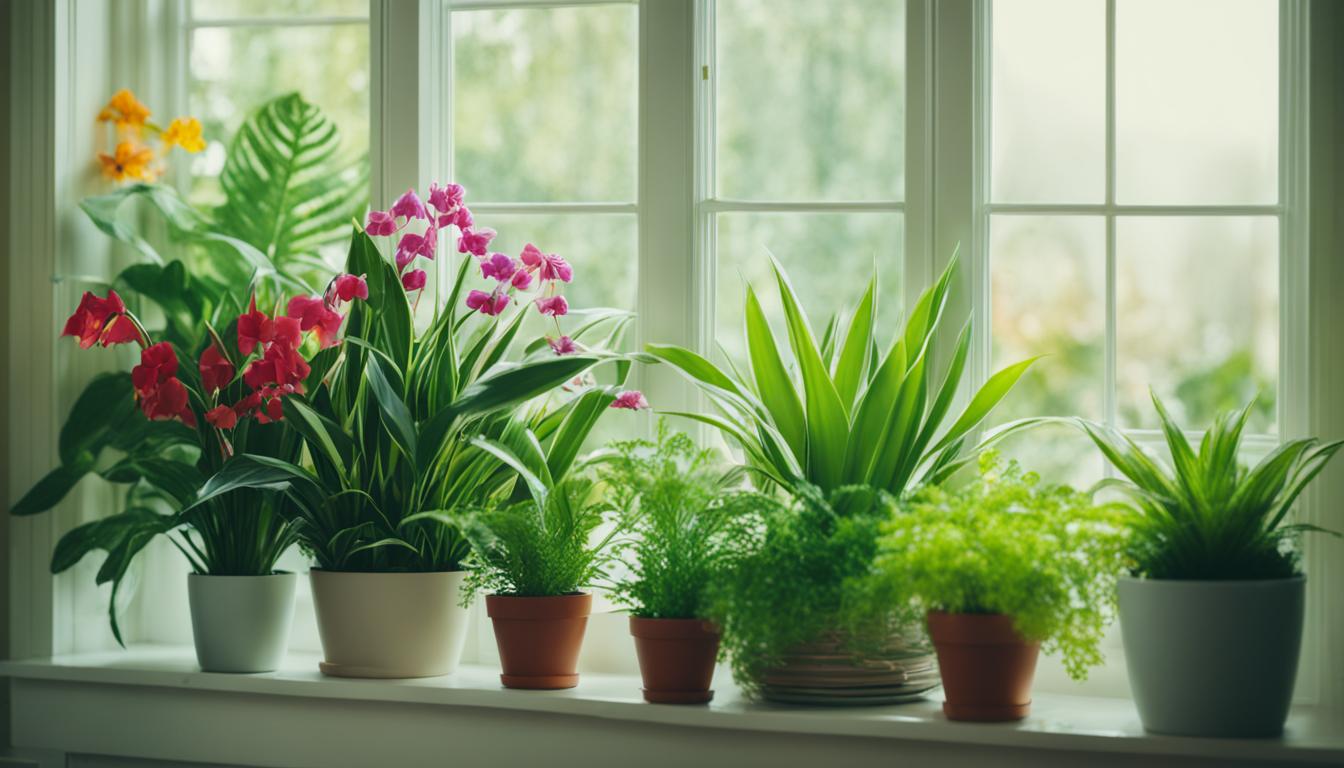Growing flowering houseplants is a wonderful way to add beauty and color to your home. Whether you have a green thumb or are new to gardening, there are plenty of options to choose from. In this article, I will share some of the best flowering houseplants that can brighten up any indoor space.
When it comes to selecting the best flowering houseplants, there are a few factors to consider. You want plants that can thrive indoors and produce vibrant blooms. Some popular choices include African violets, oxalis varieties, peace lilies, anthuriums, and Christmas cactus. These plants are known for their stunning flowers and can be grown easily in your home.
African violets are a favorite among many indoor gardeners. They bloom several times a year and come in a variety of colors and patterns. The delicate flowers and variegated foliage make them a stunning addition to any room.
Oxalis varieties, with their triangular, clover-like leaves and pale pink or white blooms, are another great choice. They are easy to care for and can tolerate varying light conditions.
Peace lilies are not only known for their elegant white flowers but also for their ability to purify the air. These tropical beauties can bloom throughout the year and are perfect for adding a touch of tranquility to your home.
Anthuriums, with their heart-shaped flowers in various shades, are sure to catch your eye. These glossy-leafed plants bring a tropical vibe to any space and are relatively low maintenance.
Christmas cactus is a popular choice for its beautiful blooms that appear during the holiday season. They require cooler temperatures and shorter days to flower, making them a perfect addition to your festive decorations.
These are just a few examples of the best flowering houseplants available. There are many more options to explore, each offering unique colors, shapes, and fragrances. By selecting the right plants and providing them with the proper care, you can transform your home into a blooming paradise.
So, why wait? Start beautifying your home with these stunning flowering houseplants and enjoy the vibrant colors and natural beauty they bring!
African Violets (Saintpaulia ionantha)
African violets are some of the most beloved flowering houseplants. These petite beauties are not only easy to grow but also bloom several times a year, rewarding your efforts with their stunning display of color. With their variegated foliage and delicate ruffled or white-edged blossoms, African violets bring a touch of elegance and charm to any indoor space.
One of the wonderful aspects of African violets is the wide variety of options available. From classic purple blooms to an array of vibrant colors, there are hundreds of cultivars to choose from. Many African violets also feature variegated leaves, adding a striking visual appeal to their overall appearance.
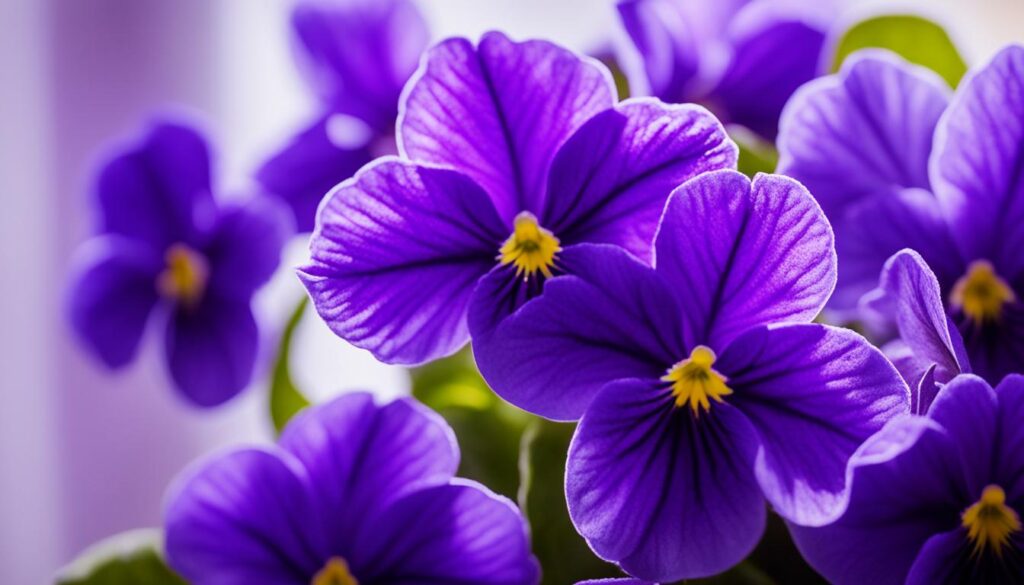
“African violets are like little bursts of happiness in your home.” – Gardening Enthusiast
To grow healthy African violets, provide them with medium to bright light, as they thrive in filtered sunlight. Placing them near a north or east-facing window is ideal. Avoid exposing them to direct sunlight, as it can cause leaf burn. Keep the soil evenly moist, using room temperature water to prevent shock to the plants. It’s best to water African violets from the bottom by placing the pot in a shallow tray of water and allowing the soil to absorb moisture.
Tips for Growing African Violets:
- Choose a well-draining potting mix specifically formulated for African violets.
- Water the plants when the top inch of soil feels dry to the touch.
- Use a balanced liquid fertilizer diluted to half strength during the growing season every 2-4 weeks.
- Avoid getting water on the leaves, as it can cause unsightly spotting.
- Regularly remove spent blooms and yellowing leaves to maintain plant health and encourage new growth.
With a little care and attention, African violets can thrive and bloom consistently, bringing joy and beauty to your home throughout the year. Consider adding these delightful flowering houseplants to your indoor garden and enjoy their captivating variegated foliage and ruffled blooms.
| Variety | Foliage Color | Bloom Color |
|---|---|---|
| Optimara Little Angel | Green with white edges | Pink |
| Rhapsodie’s Suzi Two | Green with cream highlights | Blue |
| Rob’s Love Potion | Dark green with white edges | Red |
| Fantasia Heavenly Blue | Green with white edges | Light blue |
| Teddy Bear Tootsie | Green and cream mottled | Dark pink |
Oxalis Varieties
When it comes to flowering houseplants, Oxalis varieties are a delightful choice to bring a burst of color and charm to your indoor space. These plants are known for their unique triangular, clover-like leaves that fold down at night or in dim light conditions, creating a captivating display.
There are different types of Oxalis varieties, each with its own distinct characteristics. Some varieties feature gorgeous purple leaves, while others showcase plain green foliage with or without silvery accents. These diverse foliage colors make for an eye-catching addition to any room.
But that’s not all! Oxalis varieties also grace us with their pale pink or white blooms, adding a touch of elegance to their already stunning appearance. The delicate flowers contrast beautifully against the lush green foliage, creating a mesmerizing visual display.
To ensure the optimal growth and bloom of your Oxalis plants, provide them with medium to bright light, mimicking their natural habitat. These houseplants thrive in environments with evenly moist soil, so be sure to water them accordingly. By meeting their light and moisture needs, you can enjoy a flourishing display of vibrant blossoms.
Unleash the beauty of Oxalis varieties in your home and experience the joy of nurturing these lovely flowering houseplants!
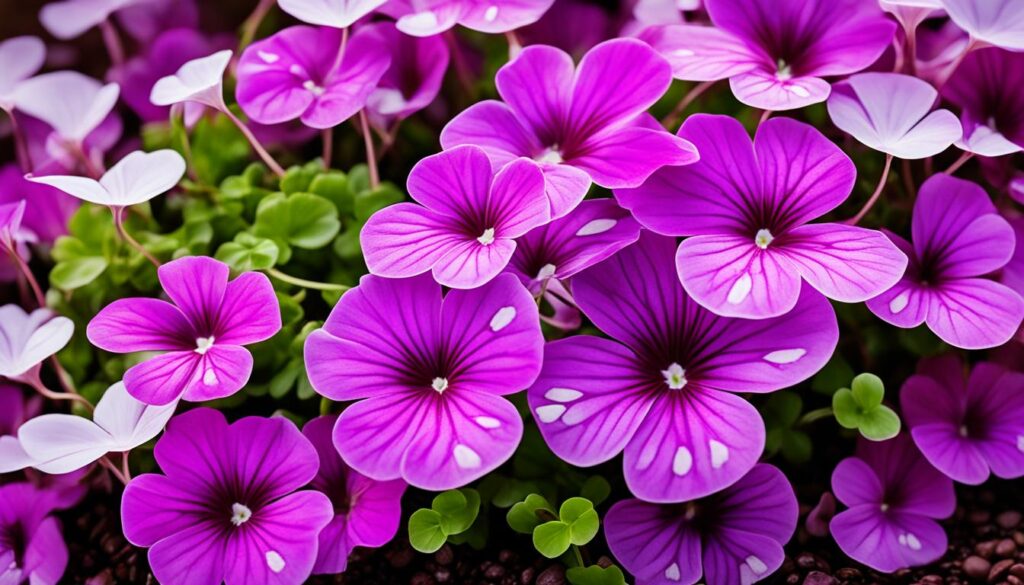
| Oxalis Varieties | Leaf Color | Bloom Color |
|---|---|---|
| Purple Shamrock (Oxalis triangularis) | Purple | Pale pink |
| Iron Cross (Oxalis tetraphylla) | Green with maroon accents | Pale pink |
| Rose Wood Sorrel (Oxalis rosea) | Plain green | White |
| Molten Lava (Oxalis vulcanicola) | Green with silvery accents | Pale yellow |
Peace Lilies (Spathiphyllum wallisii)
When it comes to flowering houseplants, peace lilies are a top choice. These elegant plants feature upright white flowers that sit atop long stems, creating a stunning visual display. With their glossy foliage and tropical vibes, peace lilies add a touch of serenity to any room.
Peace lilies have the unique ability to bloom throughout the year, but they produce the most flowers during the summer months. Their white blooms stand out against the backdrop of their large, deep green leaves, creating a striking contrast that catches the eye.
To keep peace lilies happy and thriving, they prefer a range of light conditions, from low to bright light. However, it’s important to avoid direct sunlight, as it can scorch their leaves. Additionally, peace lilies thrive in evenly moist soil, so make sure to water them regularly.
Whether you want to add a tropical touch to your living room, bedroom, or office space, peace lilies are an excellent choice. Their graceful beauty and resilience make them a favorite among indoor gardeners.
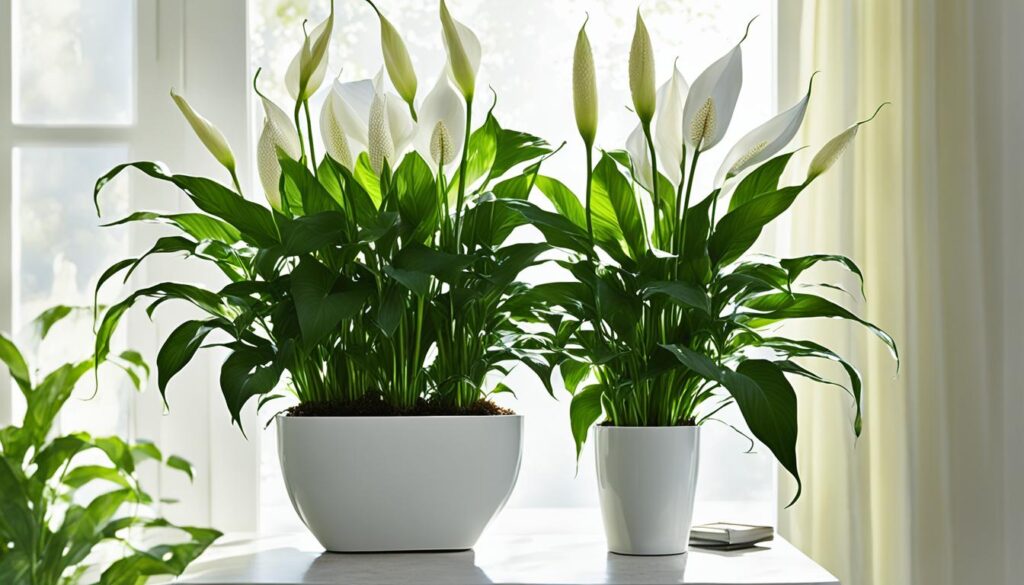
| Common Name | Scientific Name | Light Requirements | Watering Needs | Bloom Time |
|---|---|---|---|---|
| Peace Lilies | Spathiphyllum wallisii | Low to bright light | Evenly moist soil | Throughout the year, most flowers during summer |
Anthuriums (Anthurium andraeanum)
When it comes to flowering houseplants, anthuriums are a popular choice for many plant enthusiasts. Known for their unique heart-shaped flowers, anthuriums add a touch of elegance to any indoor space. These beautiful plants come in festive shades of pink, red, lavender, or white, making them a vibrant addition to your home.
One of the remarkable features of anthuriums is the long-lasting nature of their flowers. Unlike some other flowering plants, the blooms of anthuriums can endure for several weeks, bringing color and joy to your surroundings. Additionally, anthuriums are often used as cut flowers, making them a versatile choice for floral arrangements or decorative displays.
Even when not in bloom, anthuriums remain visually appealing due to their glossy green leaves. The shiny foliage adds a touch of elegance and freshness to any room. These glossy green leaves serve as a perfect backdrop for the vibrant and eye-catching flowers of the anthurium plant.
Anthuriums thrive in medium to bright light conditions, so it’s best to place them near a window where they can receive adequate sunlight. They also prefer evenly moist soil, so ensure you water them regularly without overwatering. By providing the right growing conditions, you can ensure that your anthuriums remain healthy and continue to bless your home with their beauty.
Benefits of Anthuriums:
- Heart-shaped flowers add a charming and romantic touch to your indoor space.
- Long-lasting blooms bring vibrant colors and joy to your surroundings.
- Glossy green leaves provide visual appeal even when the plant is not flowering.
- Anthuriums can be used as cut flowers to create stunning floral arrangements.
- Thrives in medium to bright light, making it suitable for various indoor environments.
Christmas Cactus (Schlumbergera spp.)
The Christmas cactus, also known as the Thanksgiving cactus, is a popular choice among flowering houseplants. These cacti bloom in response to the cool temperatures and short days of fall and winter, adding a festive touch to your indoor space. With their vibrant flowers in various colors, Christmas cacti create a stunning display that can last for several weeks.
To ensure the best blooms, provide your Christmas cactus with bright light. Place it near a window where it can receive indirect sunlight for most of the day. Avoid exposing the cactus to direct sunlight, as this can cause sunburn on its leaves.
In terms of care, Christmas cacti prefer moderately dry soil. Allow the soil to dry out slightly between waterings, but never let it become completely dry. Overwatering can lead to root rot, so it’s important to find the right balance. During the flowering period, it’s best to avoid fertilizing the cactus to prevent any stress on the plant.
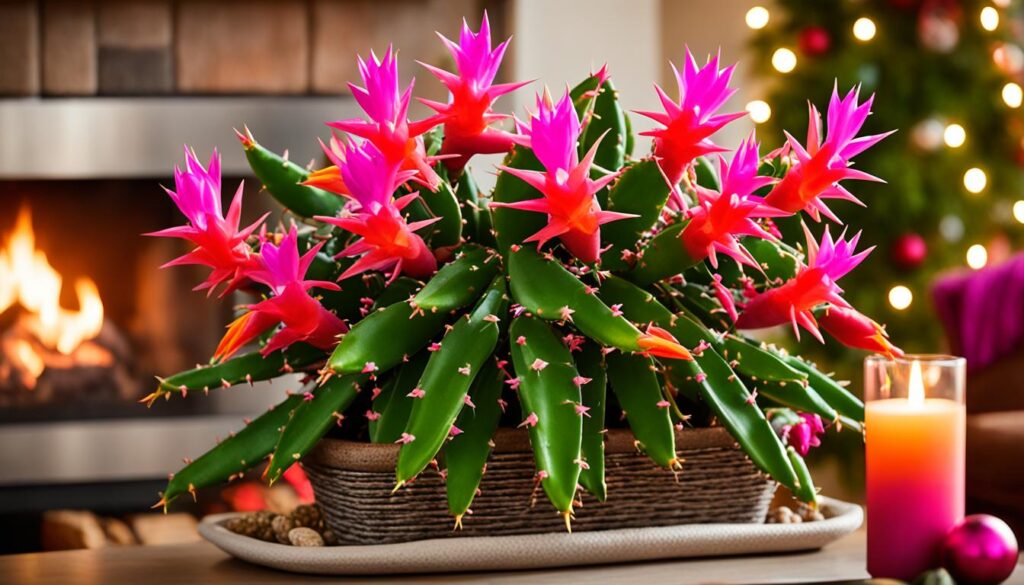
| Light | Soil | Watering |
|---|---|---|
| Bright light, indirect sunlight | Well-draining soil | Moderate watering, allowing soil to slightly dry out between waterings |
Overall, Christmas cacti are relatively low-maintenance plants that can bring a burst of color to your home during the holiday season. With proper care and the right conditions, these flowering houseplants can thrive and continue to delight you year after year.
Flowering Maple (Abutilon x hybridum)
One of my favorite flowering houseplants is the Flowering Maple, scientifically known as Abutilon x hybridum. This stunning plant captivates with its vibrant crepe-paper-like blooms in shades of red, pink, orange, or yellow. But what makes it even more special is its variegated foliage, adding an extra layer of visual interest to any indoor space.
Whether grown as trees, shrubs, or in hanging baskets, Flowering Maples are sure to draw attention and bring a touch of elegance to your home. They can reach an average height of 3 to 6 feet (90 to 180 cm), making them suitable for both small and large spaces.
To ensure the optimal growth and flowering of your Flowering Maple, it’s crucial to provide it with the right growing conditions. These plants thrive in bright to intense light, so placing them near a sunny window or providing artificial grow lights can help them reach their full potential. Additionally, Flowering Maples prefer evenly moist soil, so make sure to water them regularly, allowing the top inch (2.5 cm) of soil to dry out between waterings.
Flowering Maple Care Guide
| Light | Watering | Temperature | Humidity | Fertilizer |
|---|---|---|---|---|
| Bright to intense light | Evenly moist soil | 65-75°F (18-24°C) | 40-60% humidity | Monthly during the growing season |
With proper care, your Flowering Maple will reward you with its dazzling blooms and variegated foliage, becoming the focal point of any room. So go ahead, bring the beauty of the Flowering Maple into your home and enjoy its captivating presence.
Jasmine (Jasminum spp.)
If you are looking for a fragrant addition to your indoor garden, consider jasmine. Known for its intoxicating aroma and stunning blooms, jasmine makes for a delightful flowering houseplant. There are several types of jasmine, such as flowered jasmine and Arabian jasmine, that are easy to grow and require minimal maintenance.
Jasmine plants produce clusters of fragrant pink to white flowers that add a touch of elegance to any space. Their blossoms not only look beautiful but also fill the air with a captivating scent that can uplift your mood and create a calming atmosphere.
When it comes to the growing conditions, jasmine thrives in bright to intense light, making it ideal for placing near a sunny window or in a well-lit room. It is important to provide your jasmine plant with ample sunlight to ensure proper growth and abundant blooms.
Another benefit of jasmine is its adaptability to moderately dry soil. While it is important to keep the soil slightly moist, overwatering can lead to root rot and other issues. Therefore, allow the top inch of soil to dry out between watering sessions to maintain the ideal moisture level for your jasmine plant.
If you’re a fan of fragrant flowers and appreciate the beauty of bright and vibrant blooms, jasmine is a perfect choice for your indoor garden. With its ability to thrive in bright light and its enchanting fragrance, jasmine is a true delight for the senses.
| Jasmine Varieties | Characteristics |
|---|---|
| Flowered Jasmine | Produces delicate, star-shaped flowers |
| Arabian Jasmine | Features larger, white flowers with a strong fragrance |
| Winter Jasmine | Blooms in winter with vibrant yellow flowers |
Clivia (Clivia miniata)
When it comes to flowering houseplants, Clivia is a standout choice. Also known as kaffir lily, Clivia blooms in winter, adding a vibrant touch to your indoor space. With clusters of reddish-orange or yellow tubular flowers, Clivia creates a stunning display that is hard to resist.
What makes Clivia even more special is its preference for cool, dry conditions. For optimal blooming, it’s best to provide medium light and barely moist soil. This flowering houseplant will reward you with its magnificent flowers during the winter months, when other blooms might be scarce.
If you’re looking for a winter bloomer that will bring warmth and color to your home, Clivia is an excellent choice. Its striking reddish-orange flowers will brighten up any room and make it feel cozy and inviting.
| Common Name | Scientific Name | Blooming Season | Flower Color |
|---|---|---|---|
| Clivia | Clivia miniata | Winter | Reddish-Orange or Yellow |
Conclusion
The wide range of flowering houseplants available makes it easy to add color and beauty to any indoor space. From the delicate blooms of African violets and oxalis varieties to the stately white flowers of peace lilies and the heart-shaped blooms of anthuriums, there is a favorite indoor blooming plant for everyone.
Other vibrant flowering houseplants like Christmas cactus, flowering maple, jasmine, and clivia offer their own unique charms. With careful consideration of their specific growing conditions, you can enjoy their beauty throughout the year.
Whether you prefer the elegance of African violets or the tropical touch of peace lilies, incorporating flowering houseplants into your home can uplift your mood and create a peaceful and inviting atmosphere. So, why wait? Explore the variety of options and choose your favorite indoor blooming plants to add a burst of color and life to your living spaces.
For Fun and Peaceful setting in houseplants and more stop by our shop at The Landscape Connection and for fun video content please visit our YouTube Channel @GardeningWith The Landscape Connection
FAQ
Are African violets easy to grow?
Yes, African violets are easy to grow and bloom several times a year. They prefer medium to bright light and evenly moist soil.
What are some varieties of oxalis and how do they grow?
Oxalis varieties have triangular, clover-like leaves that fold down at night or in dim light conditions. Some varieties have purple leaves, while others have plain green foliage with or without silvery accents. They produce pale pink or white blooms and prefer medium to bright light and evenly moist soil.
How do peace lilies bloom and what are their care needs?
Peace lilies have upright white flowers on long stems above glossy foliage. They can bloom throughout the year but produce the most flowers during summer. The large, deep green leaves add a tropical touch to any room. Peace lilies prefer low to bright light and evenly moist soil.
What are the characteristics of anthuriums and how should they be cared for?
Anthuriums have heart-shaped flowers in festive shades of pink, red, lavender, or white. The flowers are long-lasting and can also be used as cut flowers. Even when not in bloom, their glossy green leaves are attractive. Anthuriums prefer medium to bright light and evenly moist soil.
When do Christmas cacti bloom and what are their light and water requirements?
Christmas cactus, also known as Thanksgiving cactus, flowers in response to cool temperatures and short days in fall and winter. They produce bright flowers in various colors and prefer bright light and moderately dry soil.
What are the characteristics and growing conditions of flowering maple?
Flowering maple has crepe-paper-like blooms in shades of red, pink, orange, or yellow. Many varieties have variegated foliage for extra interest. They can be grown as trees, shrubs, or in hanging baskets. Flowering maple prefers bright to intense light and evenly moist soil.
What types of jasmine can be grown indoors and what are their light and soil requirements?
Several types of jasmine, such as flowered jasmine and Arabian jasmine, are easy to grow and produce fragrant pink to white blooms. They thrive in bright to intense light and prefer moderately dry soil.
How do clivia plants bloom and what are their light and watering needs?
Clivia, also known as kaffir lily, blooms in winter with clusters of reddish-orange or yellow tubular flowers. They require cool, dry conditions to bloom, so they prefer medium light and barely moist soil.
Do flowering houseplants like the Calamondin orange and Brazilian fireworks require specific care?
Yes, the Calamondin orange bears fragrant white blossoms and orange fruits, while the Brazilian fireworks has deep red flower bracts and black seeds. Both of these houseplants have specific care needs. The Calamondin orange prefers bright light and evenly moist soil, while the Brazilian fireworks prefers medium to bright light and slightly drier soil.
What other indoor flowering plants are popular and what care do they require?
Other popular indoor flowering houseplants include crown-of-thorns, gloxinia, guppy plant, lipstick plant, shrimp plant, ixora, geraniums, and angel-wing begonia. Each of these plants has unique care needs in terms of light, water, and soil conditions.
What are some of the best houseplants with colorful flowers?
Some of the best houseplants with colorful flowers include African violets, oxalis varieties, peace lilies, anthuriums, Christmas cactus, flowering maple, jasmine, clivia, calamondin orange, Brazilian fireworks, crown-of-thorns, gloxinia, guppy plant, lipstick plant, shrimp plant, ixora, geraniums, and angel-wing begonia. These plants offer a wide range of vibrant blooms to beautify your home.
Which indoor flowering plants are recommended for beginners?
African violets, oxalis varieties, peace lilies, and jasmine are recommended for beginners as they are relatively easy to grow and require minimal care.
What are some stunning indoor blooming plants?
Some stunning indoor blooming plants include anthuriums with their heart-shaped flowers, flowering maple with its crepe-paper-like blooms, and lipstick plant with its scarlet flowers. These plants are sure to add beauty and vibrancy to any indoor space.


